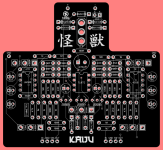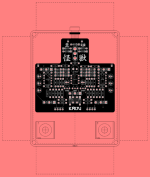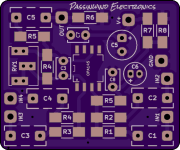Grubb
Well-known member
It's nice to see this thread still kicking at 10 pages. Obviously a lot of interest in taking DIY to the next step.
Here's what I've been working on:


It's a modified Life/Parentheses. I've recently fallen in love with this circuit, after realising how nicely it can be used as a dirty octave boost into a cranked Rectifier for crushing, reptilian doom tones (hence the Kaiju name). I've switched in an op-amp boost and also modified both buffer stages. The Rat and Ringer portions of the circuit are pretty stock. Should be fun to build and I already have a mate asking for one when I've verified the circuit.
Edit: Only one major symmetry cheat this time. Robert has ruined me with this strategy of putting fake parts on the board to make the silkscreen symmetrical haha
Here's what I've been working on:


It's a modified Life/Parentheses. I've recently fallen in love with this circuit, after realising how nicely it can be used as a dirty octave boost into a cranked Rectifier for crushing, reptilian doom tones (hence the Kaiju name). I've switched in an op-amp boost and also modified both buffer stages. The Rat and Ringer portions of the circuit are pretty stock. Should be fun to build and I already have a mate asking for one when I've verified the circuit.
Edit: Only one major symmetry cheat this time. Robert has ruined me with this strategy of putting fake parts on the board to make the silkscreen symmetrical haha







